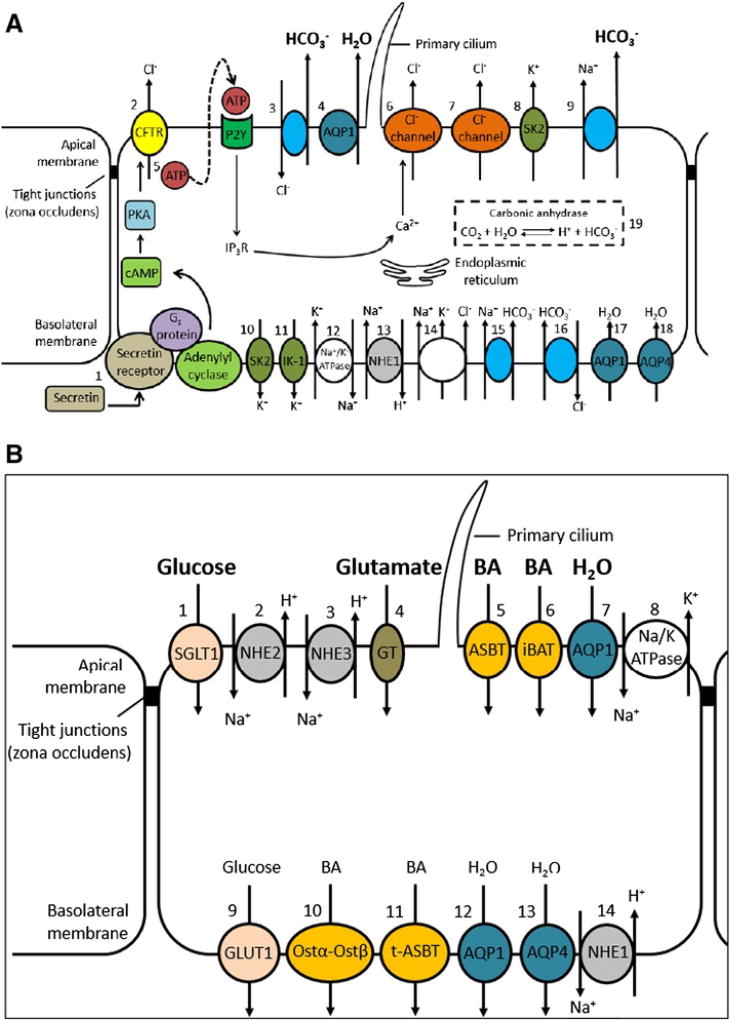Fig. 1.
A. Cholangiocyte secretory functions. The most widely accepted model of ductal bile formation involves [1] secretin activation of the cAMP-PKA signaling pathway, which then leads to [2] activation of CFTR, causing extrusion of Cl−. This then stimulates the [3] Cl−/HCO3− exchanger which secretes HCO3− and creates an osmotic gradient that leads to the [4] passive movement of water across AQP1. More recently, an alternative hypothesis suggests that [5] activation of CFTR leads to the release of ATP, which then phosphorylates IP3R on the endoplasmic reticulum. This causes the release of Cl− via the [6] Ca2+-dependent Cl− channel, which creates a gradient leading to [3] activation of the Cl−/HCO3− exchanger. Ca2+ is also transported via a [7] Ca2+- and cAMP-independent Cl− channel. Finally, the apical membrane also contains [8] K+ channels (SK2 and IK-1) and a [9] Na+-HCO3− cotransporter (mice). On the basolateral domain, there are two types of K+ channels: [10] SK2 and [11] IK-1. There is also [12] a Na+/K− ATPase, [13] a Na+/H+ exchanger (NHE1), [14] a Na+/K+/Cl− cotransporter, [15] a Na+/HCO3+ cotransporter (rats), [16] a Na+-dependent Cl−/HCO3− exchanger (humans), and water channels, [17] AQP1 and [18] AQP4. Within the cell, [19] carbonic anhydrase allows for the production of HCO3−. Abbreviations: ATP, adenosine triphosphate; AQP, aquaporin; cAMP, cyclic adenosine monophosphate; CFTR, cystic fibrosis transmembrane conductance regulator; IK-1, intermediate-conductance K+ channel; PKA, protein kinase A; NHE, Na+/H+ exchanger; SK2, small conductance K+ channel.
B. Cholangiocyte absorptive functions. Cholangiocytes have a number of transporters that allow the absorption of a variety of molecules [1]. Glucose is absorbed through SGLT1, Na+ is absorbed through [2] NHE2 and [3] NHE3, glutamate is absorbed through a glumate transporter, bile acids are absorbed through [5] ASBT and [6] iBAT and [7] water is absorbed through AQP1. On the basolateral membrane, [8] glucose is transported via GLUT1, bile is transported via [9] Ostα-Ostβ and [10] t-ASBT, water is transported via [11] AQP1 and [12] AQP4. Lastly, the basolateral membrane contains a [13] Na+/H+ exchanger (NHE3). Abbreviations: ASBT, apical sodium-dependent bile acid transporter; AQP, aquaporin; BA, bile acids; GLUT, glucose transporter; GT, glutamate transporter; iBAT, ileal bile acid transporter; NHE, Na+/H+ exchanger; OST, organic solute transporter alpha; SGLT, Na+-Glucose cotransporter.

